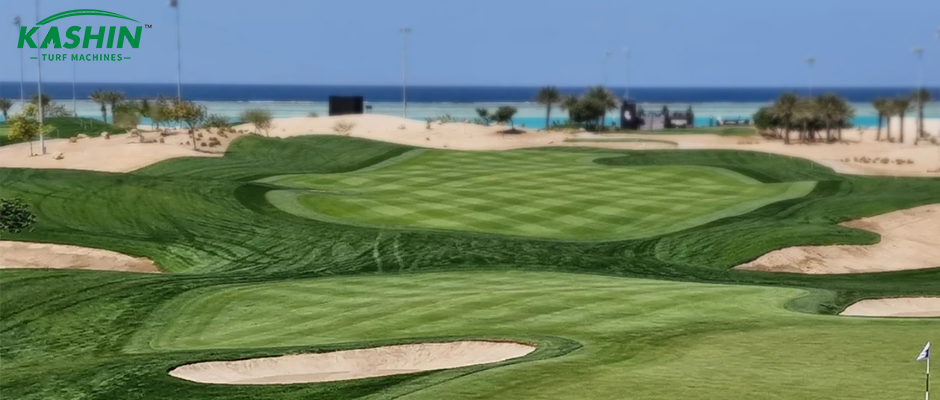1. Pruning
(1) Clean the greens for foreign objects after each pruning. Branches, stones, fruit shells, metal objects and other hard objects must be removed, otherwise they will be embedded in the green lawn and damage the blades. Ball hit marks must be repaired. Improper repair of ball hit marks will cause many dents during pruning.
(2) A dedicated greens mower must be used. The mowing frequency is generally once a day, in the morning. Reducing the number of mowing times will lead to a decrease in lawn density and wider leaves. However, when sanding, tilling or fertilizing, mowing can be stopped for at least one day. The optimal mowing height for green lawns is 4.8 to 6.4 cm, with a range of 3 to 7.6 cm. However, within the range that the lawn can tolerate, the lower the mowing height, the better.
(3) Mowing mode The direction of mowing is usually changed each time. The direction change principle is one of the four directions to reduce the production of unidirectional tillering buds. This method can be designed as the direction of a clock dial, such as 12 o’clock to 6 o’clock, 3 o’clock to 9 o’clock, 4:30 to 10:30, and finally 1:30 to 7:30. After a round with these four directions, the cycle is repeated, resulting in a clear grid-shaped strip pattern.
(4) Removal of clippings. The lawn is collected in a grass box after being clipped and then removed from the green. Otherwise, the grass clippings may make the lawn below less breathable and cause pests and diseases.
(5) Control of unidirectional tillering buds on the lawn. Accessories such as brush-type grass combs of green lawn mowers can be used to correct or prevent the formation of unidirectional tillering buds. When the lawn is growing vigorously, a slight vertical trimming of the green lawn every 5 to 10 days can correct the problem of unidirectional tillering buds. The grass comb or vertical mower should be adjusted to the surface of the lawn.
(6) Things to note during pruning: Operators should wear flat shoes to avoid damage to the greens caused by spiked soles; When pruning, be careful to prevent gasoline, engine oil or diesel from leaking and falling on the lawn to produce small dead spots; Pay attention to turf scratches, which are generally caused by the turf not being tight enough or the grass mat being too thick and not smooth enough. After the rain, the grass mat will swell after soaking, which can easily make the turf soft. It should be adjusted to 1.6 cm higher and prune every few days or 1 to 2 days.

2. Fertilization
(1) Fertilization time: Usually, full-price fertilizers containing nitrogen, phosphorus and potassium are applied in spring or autumn. In the rest of the growing season, nitrogen fertilizers need to be supplemented regularly.
(2) Fertilization method: It is better to apply dry fertilizers with a centrifugal spreader and finally apply in a vertical direction. Especially water-soluble fertilizers, usually apply when the leaves are dry, and irrigate immediately after application to avoid burning the leaves. To prevent the lawn from being burned by fertilizer, you should pay attention to the following: do not apply fertilizer after the grass has just been cut; do not cut the grass on the day of fertilization; do not install a grass collector when mowing; puncture the green before fertilization. Sufficient nitrogen fertilizer must be applied to maintain the basal bud density of the lawn grass, sufficient recovery potential, basal bud growth rate and maintain normal color. Generally, 1-2.5g/m2 of nitrogen is applied every 10-15 days. Potassium fertilizer: Since the bed of the green lawn is sandy, potassium fertilizer is easy to leak, which is not conducive to maintaining the heat resistance, cold resistance, drought resistance and trampling resistance of the lawn and promoting root growth. Finally, determine the potassium fertilizer application plan based on the results of soil analysis. Generally, the potassium fertilizer demand is 50% to 70% of nitrogen, and sometimes more potassium fertilizer is more ideal. In high temperature, drought and long trampling time, apply potassium fertilizer every 20-30 days. Phosphorus fertilizer; the demand for phosphorus fertilizer is small, and it should also be carried out according to the results of soil analysis, generally in spring and late summer and early autumn.
3. Irrigation
Irrigation is one of the most important maintenance measures for green lawns. It should be determined based on the specific needs of each green and its influencing factors.
Post time: Dec-05-2024
